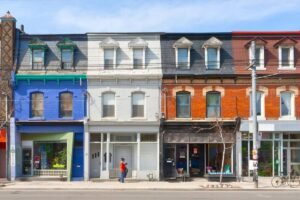[April 15, 2008] In the subprime mortgage foreclosure fiasco, nonprofit organizations have stood out as relative successes compared to their counterparts in the for-profit financial sector and among federal government agencies.
Every review I’ve seen of the affordable housing inventories of nonprofit community development corporations (CDCs) indicates minimal subprime mortgage foreclosure problems. Unlike the housing units built and frequently self-financed by private developers, CDCs and most other nonprofit housing developers steered low-income home purchasers away from exotic mortgages with interest rates scheduled to explode in two or three years.
Moreover, CDCs didn’t shove mortgage products that they knew purchasers couldn’t afford. CDCs and other solid nonprofit housing developers appear to have emphasized homeowner education and counseling—both pre- and post-purchase—to ensure that buyers would not only qualify for mortgages on day one, but be able to pay principal and interest for years down the line. And, nonprofits certainly weren’t pushing “cash-out” refinancing loans that have led to foreclosures on so many older, inner city homeowners who thought they could grab some quick pocket cash.
Nonprofits have distinguished themselves from government agencies as well. Nonprofit housing developers are in the forefront of crafting solutions to the subprime mortgage foreclosure problem. Federal agencies like Treasury, committed first and foremost to protecting the banks and investors, and Housing and Urban Development, now undergoing its latest implosion in the wake of Secretary Alphonso Jackson’s scandal-ridden departure provide a stark contrast with the series of powerful reports issued by the nonprofit Center for Responsible Lending and others which for years warned federal agencies about the magnitude and scope of the subprime foreclosure disaster that, as they predicted, has come to pass.
Nationally, the nonprofit Neighborhood Reinvestment Corporation—operating as the NeighborWorks America network—offered to serve as the clearinghouse for taking a Congressional appropriation to vastly expand nonprofit housing counseling resources. On a short timeframe, NeighborWorks America designed a system for distributing $180 million to expand the capacity of existing housing counseling agencies that were willing to help homeowners try to restructure their mortgages and stave off foreclosures.
Sign up for our free newsletters
Subscribe to NPQ's newsletters to have our top stories delivered directly to your inbox.
By signing up, you agree to our privacy policy and terms of use, and to receive messages from NPQ and our partners.
Early returns suggest that the banks and particularly the mortgage servicers are proving less forthcoming in restructuring mortgage terms, preferring to negotiate three-to-six month payment schedule modifications and such, but not alter the basic rates and amounts of subprime mortgages. It may be that NeighborWorks and others gave the banking and servicer members of Treasury’s “Hope Now” coalition more “credit” than they deserved. They seem to be more concerned with protecting investors who purchased subprime mortgage-backed securities rather than helping the millions of homeowners at risk of losing their homes. But bills being pushed by legislators such as Chris Dodd (D-CT) in the Senate and Barney Frank (D-MA) in the House, among others, might spur banks and servicers to do more.
At a recent conference of the National Association of Community Economic Development Associations (NACEDA), CDCs and other nonprofits presented what they were doing to tackle the flood of vacant properties and displaced households that have inundated neighborhoods from coast to coast. In Cleveland, the East Side Organizing Project (ESOP) is making progress in neighborhoods such as Slavic Village through fair lending agreements to get banks to turn over properties to local groups for rehabilitation and resale. In northern New Jersey, a nonprofit developer called HANDS is fashioning a plan to acquire blocs of foreclosed properties from lenders and servicers and work with a number of CDCs to bring them back onto the markets.
Working with owners who haven’t yet lost their homes, the Neighborhood Assistance Corporation of America (NACA) is among the most aggressive and most successful national nonprofits engaged in refinancing the mortgages of families facing subprime-induced foreclosures. Building off local or regional models for the acquiring and rehabbing vacant properties, the Center for American Progress in partnership with Enterprise Community Partners has proposed the Great American Dream Stabilization (GARDNS) Fund, to be capitalized by a special multi-billion dollar Community Development Block Grant appropriation. Legislative proposals from Dodd and others reflect the GARDNS concept.
Nonprofits are not going to solve the subprime mortgage crisis on their own. The problem is huge and merits a federal commitment geared to helping homeowners and stabilizing neighborhoods rather than bailing out Bear Stearns and others. But to their credit, some nonprofits are crafting policy initiatives and programmatic models to show what is needed in terms of solutions. If only the White House and Congress can see, hear, and respond.











